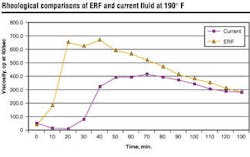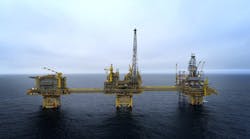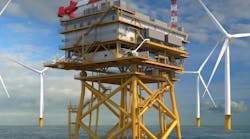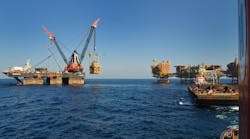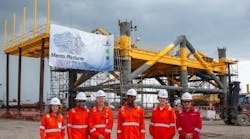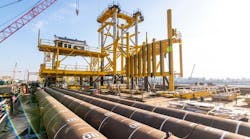Hydraulic fracturing has become an important function in sand control completions for many highly productive oil and gas wells in the Gulf of Mexico. Many of the chemicals and materials developed for onshore fracturing operations were taken offshore when frac-and-pack completions were introduced in the Gulf.
To minimize any potential risk to this new environment, it is prudent to develop fracturing fluids and additives that meet or surpass environmental regulations for marine discharge. The goal is to eliminate any potential risk to the environment where the work is being conducted.
For offshore operations, designing a fracturing fluid that can be discharged without introducing any environmental impact would be a tremendous step toward eliminating potential environmental hazards. Although responsible use of these products dictates that discharges be avoided whenever possible, a material that meets these requirements offers significant operational and logistical advantages.
Compliance with environmental regulations is a top priority, but fluid performance characteristics are also vital to achieving desired well productivity goals. In the high-permeability deepwater wells currently under development in the Gulf of Mexico, development and operating costs can be very high. High well productivity is critical to the success of the field. Expected oil production rates in these reservoirs can be in excess of 30,000 b/d. To maintain these high production rates requires a high-performance fracturing fluid combined with successful job execution. The critical performance requirements for such a fluid include:
- Operational simplicity to provide consistent and repeatable results.
- Low pipe friction to minimize surface treating pressures during fracturing operations.
- Fluid loss control to create sufficient fracture geometry to achieve the desired production results over a wide range of reservoir conditions.
- Rheological characteristics that are suitable for good proppant transport into the created fracture and that provide for easy removal or clean-up after the treatment is placed.
- Fluid composition that is non-damaging to the reservoir rock and the reservoir fluids: (1) compatible with formation fluids; (2) compatible with formation minerals.
- High retained fracture conductivity.
An ideal offshore fracturing fluid is one that maintains performance characteristics while also addressing marine environmental requirements.
New fluid development
Environmental regulations for the Gulf of Mexico dictate that to be discharged overboard, a fluid must meet the following requirements:
- Static sheen test: no visible sheen
- Oil and grease test: 29 mg/liter or less
- Composition test: must contain no chemicals or chemical components that are on the non-discharge list.
The goal of this development process was the creation of a seawater-based, crosslinked system that would provide the desired performance characteristics as well as passing environmental requirements to permit marine discharge. Although there is no toxicity requirement specific to fracturing fluids, completion fluids, and workover fluids, the guidelines for drilling fluid effluent were adopted as a safe option. The toxicity testing requirement used in the development of this fluid was a minimum 96-hour LC50 of at least 30,000 ppm to Americamysis bahia.
The first step taken by Halliburton Energy Services in the fluid design process was to tackle the static sheen and the oil and grease testing requirements. A guar-based fluid was selected at the start of the project because the basic polymer used to create viscosity in guar-based fluids is an organic polymer that is environmentally acceptable. However, since many of the components commonly used in guar-based fracturing fluids use a hydrocarbon solvent or dispersion, it was necessary to reformulate several components. Concentrations as low as 0.5 gal/Mgal of surfactant, which contained a hydrocarbon solvent, would not pass the oil and grease test.
First, a new non-oil-based gel concentrate was developed that allowed the guar to be transported and mixed as a high-concentration liquid rather than a dry powder. This provided operational simplicity and allowed the system to be used without making major equipment modifications on the stimulation vessel. Also, a solid surfactant containing no hydrocarbon solvent was developed to provide the desired low-surface-tension properties to improve fluid clean-up and provide compatibility with reservoir fluids. A delayed borate crosslinker was developed using both water-based systems and glycol ether carriers. This provided acceptable results on the oil and grease tests.
Achieving suitable ratings on the LC50 toxicity testing also presented several challenges. To achieve the best possible results, the system was essentially built and tested incrementally, selecting the options that provided the best performance. The use of potassium chloride to provide improved protection against clay swelling was found to have a severely negative effect on the toxicity test results, producing an LC50 of approximately 220,000 ppm, compared to sodium chloride (LC50 > 1,000,000 ppm). As a result, potassium chloride was replaced with sodium chloride, without any negative impact on system performance.
Most of the conventional breaker and additive packages yielded successful results, with LC50 readings ranging from < 278,000 ppm to > 1,000,000 ppm. However, the high-temperature breaker system that is very commonly used did not fair well in the LC50 tests. Fluids containing this chemical package yielded toxicity results of LC50 < 30,000 ppm, which did not meet the desired minimum requirements.
The only means of achieving an acceptable result with this component was to add a neutralizing agent to the system that essentially deactivates the chemical. Incorporating a neutralizing agent brought the LC50 results up to in excess of 50,000 ppm, allowing the fluid to pass the desired requirements.
It was also found that although both the water-based and glycol ether-based crosslinkers performed well, the water-based crosslinker provided better toxicity performance.
Performance testing
The performance testing of the fluid was a continual process in which the system is optimized for specific well conditions (such as temperature and reservoir fluid). During the early phases of fluid evaluation, it is not uncommon to conduct a full suite of tests for several treatments to become familiar with the new fluid.
The performance testing was undertaken to address some of the basic fluid requirements, such as operational simplicity and rheological properties. At this point, additional performance testing was completed to evaluate gel breaker performance, compatibility with reservoir fluids, regained formation permeability, and fracture conductivity.
From an operational standpoint, the new fluid has performed well. When introducing new fluid systems, it is always advantageous to minimize significant equipment or procedure modifications that may be difficult to adopt into the operation.
In most cases, the new system has involved chemical substitutions to improve environmental performance, while requiring little if any modification to existing mixing procedures or equipment. In this case, the fluid required only minor changes in on-site operating procedures.
The improved viscosity showed that the substitution of NaCl for KCl provided a system that behaved more favorably to the crosslinker. With the current systems, it is often necessary to add a secondary crosslinker material to prevent long delays in crosslink time.
The use of a secondary crosslinker presents several operational challenges to achieve the desired results on location. Also, the overall apparent viscosity of the new fluid exceeds that of the current fluid, even after the fluids are both fully crosslinked. Overall, the environmentally responsible fluid has better rheological properties than the systems now being used.
Testing of regained permeability and retained fracture conductivity is still in process, but early results have shown that the new fluid performs at least as well as the fluid currently being used for frac-and-pack service completions in the Gulf of Mexico.
The success of the fluid demonstrates that it is possible to use environmental guidelines during development of a fracturing fluid to meet discharge requirments, yet still provide the same, or better, performance as fluid systems currently in use. The resulting fluid system minimizes the potential for serious environmental incidents without compromising the performance and productivity required to make large projects profitable and attractive for commercial development.
The creation of such a fluid does not justify the routine discharge of such components, but the use of such materials helps minimize environmental impacts associated with drilling and production operations. Also, the materials are easier to handle on location, which reduces environmental risk, offers logistical advantages, helps to streamline operations, and reduces unnecessary rig time. With daily rig costs for deepwater rigs in the range of $300,000/day, minimizing risk and reducing down time becomes an attractive option.
While the fluid was developed to meet environmental requirements for the Gulf of Mexico, it may not meet environmental requirements for other active offshore environments around the world, due to a large degree of variation in local regulations and requirements. An apparent lack of cooperation in setting environmental standards for offshore regions around the world represents a tremendous challenge in the development of more environmentally responsible chemicals and fluid systems.


